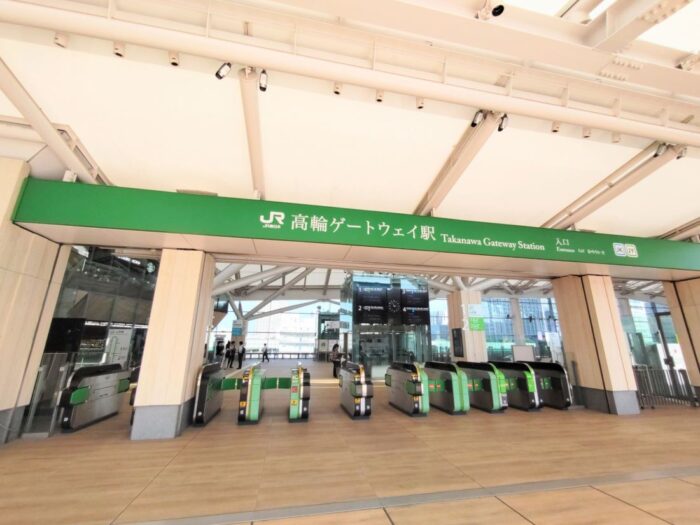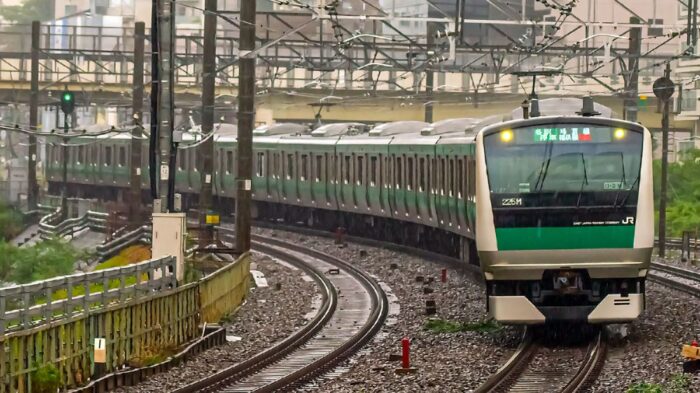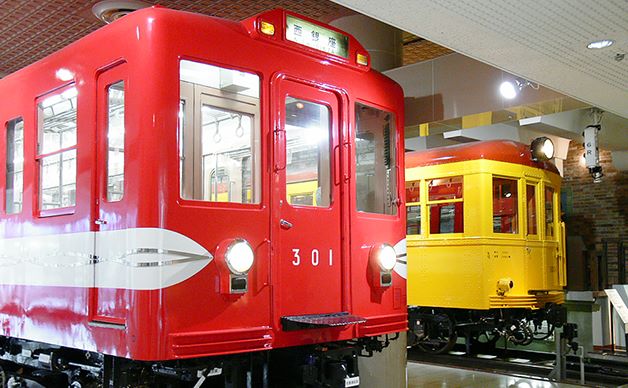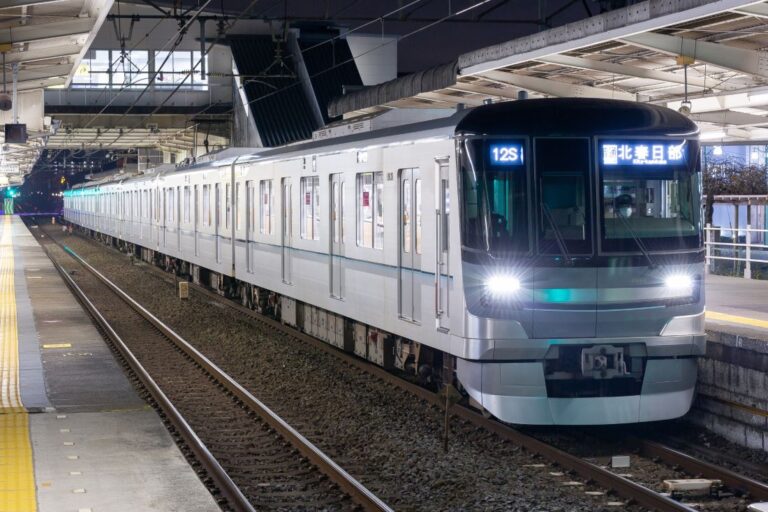It’s no exaggeration to say that The Yamanote Line is Tokyo’s most important train line and connects many of the most popular tourist destinations. The iconic Line is a circular route that runs through the heart of Tokyo, making it an easy and convenient way to, quite literally, get around the city.

In this guide, we will check out stations on the Yamanote Line, including their unique features and attractions. You will also discover the best places to eat, shop, and explore in each neighborhood. From the trendy streets of Shibuya to the historic temples of Ueno, the Yamanote Line can take you to many of Tokyo’s iconic locations and attractions.
Route Map and Stations

The line is operated by JR East and runs in a loop around central Tokyo, stopping at 29 stations. The entire loop takes approximately one hour to complete.
Here is a list of the 29 stations on Line, starting from where else but Tokyo Station:
| Station Name | Transfers |
|---|---|
| Tokyo | Keihin-Tohoku Line, Tokaido Line, Chuo Line, Marunouchi Line |
| Kanda | Ginza Line |
| Akihabara | Sobu Line, Keihin-Tohoku Line, Hibiya Line |
| Okachimachi | Keihin-Tohoku Line |
| Ueno | Keihin-Tohoku Line, Joban Line, Ginza Line, Hibiya Line |
| Uguisudani | Keihin-Tohoku Line |
| Nippori | Keisei Main Line, Joban Line |
| Nishi-Nippori | Chiyoda Line |
| Tabata | Keihin-Tohoku Line |
| Komagome | Namboku Line |
| Sugamo | Mita Line |
| Otsuka | Toden Arakawa Line |
| Ikebukuro | Tobu Tojo Line, Seibu Ikebukuro Line, Marunouchi Line, Yurakucho Line, Fukutoshin Line |
| Mejiro | None |
| Takadanobaba | Seibu Shinjuku Line, Tozai Line |
| Shin-Okubo | None |
| Shinjuku | Chuo Line, Sobu Line, Odakyu Line, Keio Line, Marunouchi Line, Oedo Line |
| Yoyogi | Oedo Line |
| Harajuku | Chiyoda Line |
| Shibuya | Ginza Line, Hanzomon Line, Fukutoshin Line, Denentoshi Line, Toyoko Line |
| Ebisu | Hibiya Line |
| Meguro | Namboku Line, Mita Line |
| Gotanda | Asakusa Line |
| Osaki | Saikyo Line, Shonan-Shinjuku Line |
| Shinagawa | Keihin-Tohoku Line, Tokaido Line, Yokosuka Line, Keikyu Main Line, Asakusa Line, Narita Sky Access Line |
Fares and Tickets

The JR Yamanote Line is one of the most convenient and affordable ways to get around Tokyo. In this section, we will discuss the fares and tickets available for riding the Yamanote Line.
The Line is operated by Japan Railways (JR), and fares are based on the distance traveled. The fare for a single ride ranges from ¥140 to ¥320, depending on the distance traveled. The fare for a full loop around the Yamanote Line is just ¥290.

There are several ticket options available. The most popular option is the Suica or Pasmo IC card, which can be used on all trains and buses in Tokyo. These cards can be purchased at ticket vending machines in all JR stations, and can be recharged as needed. The cost of a Suica or Pasmo card is ¥2,000, which includes a ¥500 deposit that can be refunded when the card is returned.
Another option is to purchase a single-ride ticket. These tickets can be purchased at ticket vending machines in all JR stations, and are valid for one ride on the Yamanote Line. The cost of a single-ride ticket ranges from ¥140 to ¥320, depending on the distance traveled.
For travelers who plan to use the Yamanote Line frequently, a one-day pass may be a more cost-effective option. The Tokyo Free Kippu pass allows unlimited travel on all JR trains, buses, and subways in Tokyo for one day. The cost of the Tokyo Free Kippu pass is ¥1,590.
Rush hour can be extremely crowded, and avoid traveling during these times if possible. During rush hour, trains on the Yamanote Line can pass each other every 2.5 minutes, making it difficult to find a seat. However, if you must travel during rush hour, be prepared for a crowded and uncomfortable ride.
Tips for Riding the Yamanote Line

Here are some tips to make your ride smoother:
- Avoid rush hour if possible. Rush hour on the Yamanote Line can be extremely crowded, especially during weekday mornings and evenings. If you can, try to schedule your travel during off-peak hours.
- Be prepared to stand. During peak hours, it may be difficult to find a seat on the Yamanote Line. If you’re not comfortable standing for an extended period of time, consider traveling during off-peak hours.
- Pay attention to the train announcements. The Yamanote Line has both Japanese and English announcements, so listen carefully to ensure that you don’t miss your stop.
- Don’t eat or drink on the train. Eating and drinking are not allowed (or at least frowned upon) on the Yamanote Line, so be sure to finish your food and drink before boarding.
Popular Attractions and Places to Visit Along the Yamanote Line
The Yamanote Line is a popular train line that circles around Tokyo’s major city centers. It is a convenient way to travel to some of the most popular attractions and places to visit in Tokyo. Here are some of the most popular attractions and places to visit along the Yamanote Line:
| Station | Attraction/Place to Visit |
|---|---|
| Shinjuku Station | Shinjuku Gyoen National Garden, Tokyo Metropolitan Government Building, Kabukicho |
| Harajuku Station | Meiji Jingu Shrine, Takeshita Street, Omotesando |
| Shibuya Station | Shibuya Crossing, Hachiko Statue, Center Gai |
| Ebisu Station | Yebisu Garden Place, Museum of Yebisu Beer |
| Meguro Station | Meguro River, Nakameguro |
| Gotanda Station | Gotanda Gekijo, Tokyo Metropolitan Teien Art Museum |
| Shinagawa Station | Takanawa Gateway Station, Hara Museum of Contemporary Art, Happoen Garden |
| Hamamatsucho Station | Tokyo Tower, Zojoji Temple |
| Yurakucho Station | Ginza, Tokyo International Forum |
| Ikebukuro Station | Sunshine City, Tokyo Metropolitan Art Space |
History of Yamanote Line

The Yamanote Line has an interesting history that dates back to the late 19th century. The line was first opened in 1885 by the Nippon Railway Company, which was later acquired by the government and became part of the Japanese National Railways (JNR) in 1949. The line was originally built to connect Tokyo’s major city centers and provide a convenient mode of transportation for commuters.
Over the years, the Line has undergone several changes and improvements. In 1925, the line was electrified, which made it faster and more efficient. The line was also extended to include new stations, such as Shinagawa Station and Ikebukuro Station, to accommodate the growing population of Tokyo.
During World War II, it suffered extensive damage due to air raids. However, it was quickly rebuilt after the war and continued to serve as a vital transportation link for the city. In the 1980s, the line underwent a major renovation project that included the installation of new trains and the modernization of stations.
Today, the Yamanote Line is operated by the East Japan Railway Company (JR East) and remains one of Tokyo’s busiest and most important transportation links. It is a circular line that connects 29 stations, including some of the city’s most popular destinations, such as Shibuya, Shinjuku, and Tokyo Station.
A trip around the whole circle takes approximately one hour, and the line carries an average of 3.6 million passengers per day. The Yamanote Line has well and truly become an iconic symbol of Tokyo and is an essential part of the city’s transportation network.
The Sum Up
The Yamanote Line in Tokyo is a vital part of the city’s transportation system, connecting travelers to some of the most important and iconic neighborhoods in the city. With its 29 stations, the line offers a convenient and efficient way to explore Tokyo and its many attractions.
Whether you’re a first-time visitor or a seasoned traveler, the Yamanote Line is an essential part of any Tokyo itinerary. From the bustling streets of Shibuya to the historic temples of Ueno, the line gives you access to some of the city’s most popular destinations.
As we’ve seen in this guide, there are plenty of tips and tricks to help you make the most of your Yamanote Line experience. From avoiding rush hour crowds to using the line as a sightseeing tour, there are many ways to enjoy the convenience and efficiency of Tokyo’s iconic subway line.
So whether you’re a local commuter or a curious traveler, be sure to take advantage of the Yamanote Line’s many benefits. With its frequent service, extensive coverage, and affordable fares, it’s the perfect way to explore one of the world’s most exciting and vibrant cities.
Where To Stay In Tokyo
Tokyo visitor levels are currently at an all-time high so make sure to book your hotels early. Tip most hotels booked with booking.com have free cancelation so book as soon as you know your date and you can always cancel if you change your mind.






